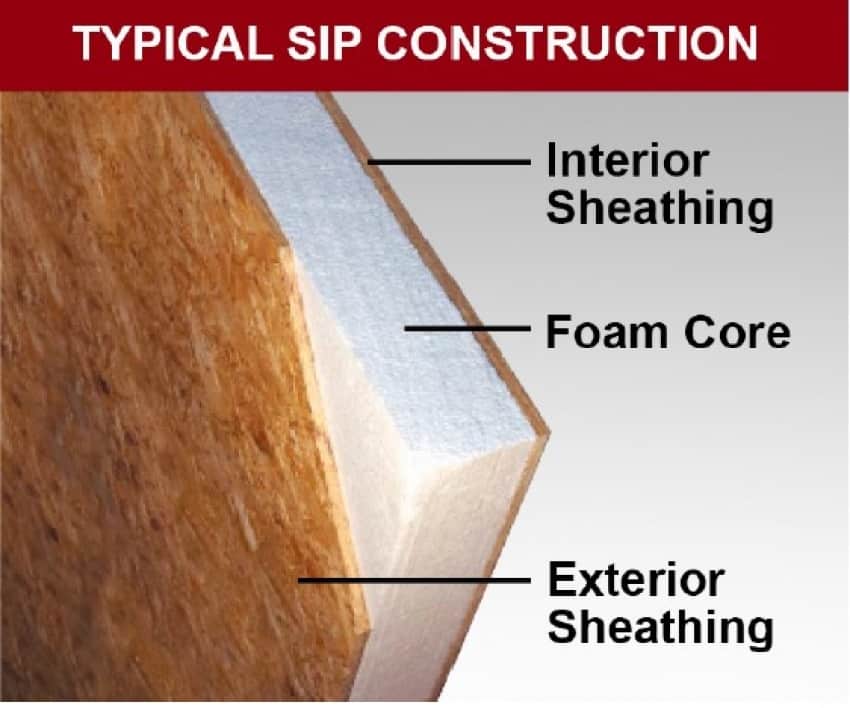It doesn't matter if you are building a residential home or a commercial building, more owners want spaces that are energy-efficient and environmentally friendly. As a replacement for construction methods using traditional framing lumber and insulation, SIPs provide an extremely durable, strong, and energy-efficient building option.
What Is SIP Construction?
Structural insulated panels (SIPs) are factory-made to the precise measurements of a building’s design. SIPs are made as a composite by layering a rigid insulating material between outer boards. The panels are strong and very well insulated. They are also lightweight and easy to erect due to their design.
SIPs are used to construct walls, ceilings, and floors. They come in a variety of different shapes, sizes, densities, and thicknesses. SIPs can be customized to suit the needs of any home or building. The most common types of structural insulated panels are:
- Expanded polystyrene insulated panels: The majority of SIPs are manufactured using expanded polystyrene (EPS) foam board insulation, a closed-cell type of insulation.
- Polyurethane or polyisocyanurate insulated panels: These panels are usually manufactured as panels for walls and ceilings. They are more resistant to water and fire and have a higher R-value.
- Compressed straw-core insulated panels: These are manufactured using a renewable and recycled waste agricultural straw.
Benefits Derived from SIP Construction

SIPs became popular in the commercial construction market as builders were finding ways to conserve natural resources. This is an alternative to standard framing methods using dimension lumber. Although it is still less common than wood framing, SIP construction has economic advantages that should be weighed when designing a commercial or residential building.
1. Energy Cost Savings
SIP-built homes not only provide a healthy environment for your family to live in, but they also help you save on energy bills. These panels reduce air drafts, resulting in a huge decrease in heating and cooling costs. Many modern, energy-efficient homes also qualify homeowners for an array of federal, state, and local energy initiatives that are issued in the form of rebates or tax incentives.
2. Lower Labor Costs
Structural insulated panels can reduce the amount of installation time. They are lightweight and easy to assemble, reducing construction time and fees. Less supervision is required on the building site and no specialized tools are needed. With this shorter installation time, labor costs are reduced and there is less job-site waste. Precut SIPs reduce waste management costs and landfill fees.
3. Insulation Cost Savings
The insulation of your home is already included in these panels when they arrive, helping you save on another expensive home-building expense. SIPs come prefabricated, so they don’t need to be cut to size, resulting in less waste of costly building materials.
4. Less Loan Interest
Using factory pre-cut wall and roof panels, a SIP-built house can be installed in days instead of weeks. If you are building under a construction loan, you can expect to save between 2 and 4 weeks’ worth of interest.
5. Cheaper Interior Finishing
The time savings with SIP Construction extends to the building’s interior too. SIPs reduce drywall, trim, and cabinet installation time. Callbacks due to popped drywall nails and screws are eliminated. There is less drywall waste and fewer seams because drywall does not have to be trimmed to terminate exactly on a stud.
6. Cheaper Electrical Installation
Electrical installations take less time when SIPs are used. The pre-installed wire chases in structural insulated panels eliminate the need to drill studs for electrical wiring.
Other Advantages of SIP Construction
Besides the economic advantages, SIPs offer benefits at all levels of design, building, and construction. Everyone involved in the project, including architects, designers, builders, and the residents, SIP construction benefits are spread around.
SIPs can be used for internal and external walls, floors, and roof surfaces. They are strong panels that provide a structurally sound home that is less susceptible to shifting. Because of this, roof trusses are not necessary. This allows for living space beneath the roof of a house.
Members of the design team can offer input in the earliest stages of selecting panels and building design. SIPs offer more creative freedom for architects and designers due to the ease of creating CAD drawings.
Existing buildings that used traditional framing can be remodeled using SIPs. They can be used in different residential and commercial applications.
Trusted Construction Professionals
Whether you prefer traditional framing methods or SIP construction, RT Construction can design and build your dream home. Our experienced team will ensure your new home is structurally sound and has what you need and want. Contact us today to get started on your next project.
